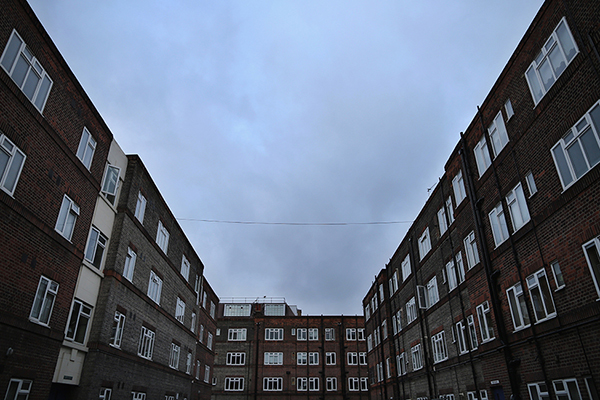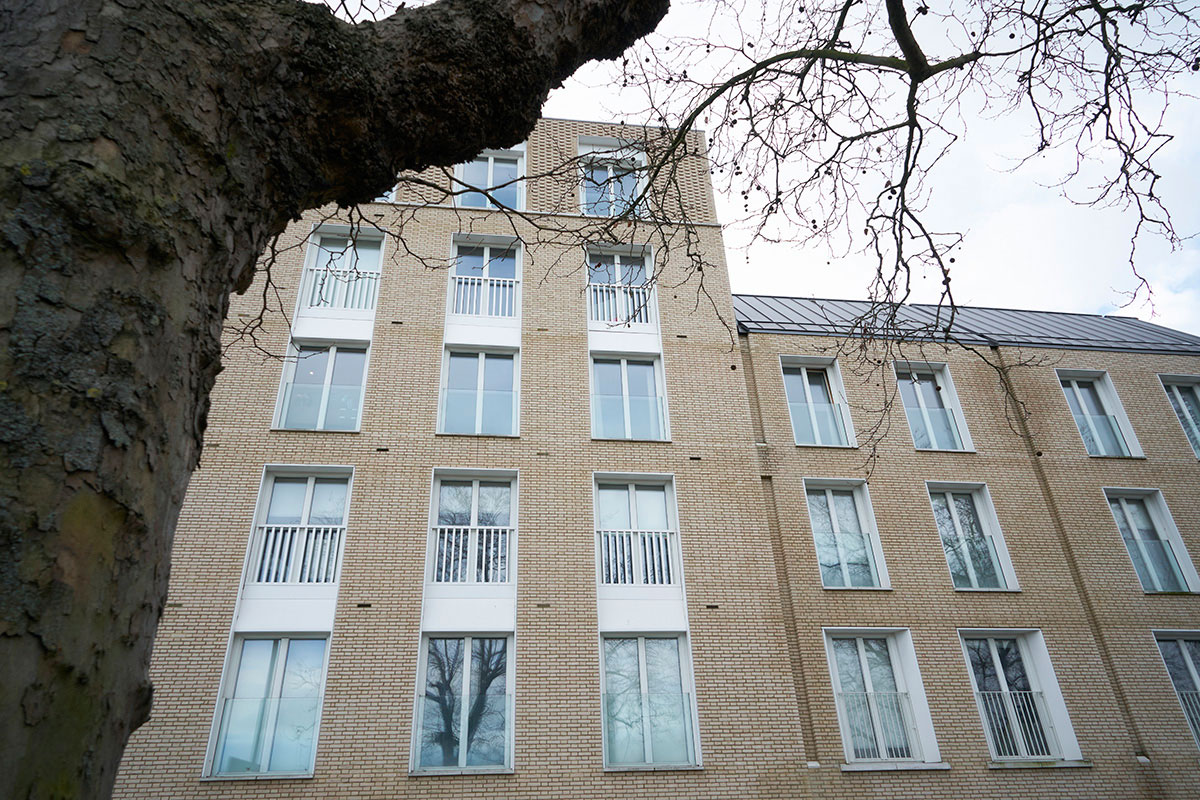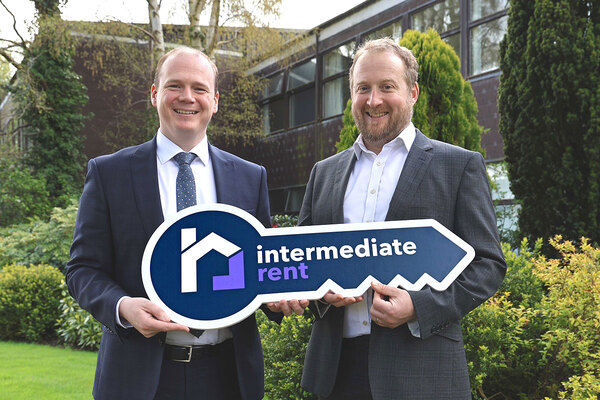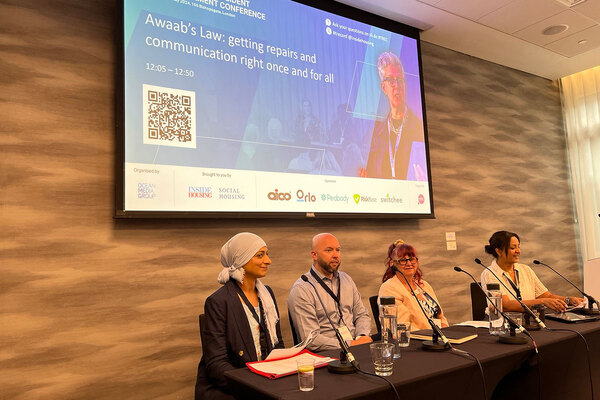You are viewing 1 of your 1 free articles
What has happened to the Dolphin Living dream?
Dolphin Living hoped to become a modern Peabody, building hundreds of homes at rents personalised to tenants’ incomes, without using government grant. Keith Cooper looks at what happened when the dream of doing things differently met bureaucratic reality. Photography by Julian Anderson
Dolphin Living has a reputation for saving tenants from unaffordable rent rises. It first made headlines in 2014 by buying the New Era Estate in Hackney, rescuing its private rent tenants from a 10% rent rise that would make their homes unaffordable, in a campaign led by comedian Russell Brand. Its second act came in 2016 when it bought 49 homes on the Butterfields Estate in Walthamstow, after its new owner issued many of its tenants with eviction notices.
The landlord started as a subsidiary of the Dolphin Square Charitable Foundation. It was set up in 2005 by the Dolphin Square Trust and Westminster Council after they sold their leasehold interests in Dolphin Square, an iconic apartment block in Pimlico. The foundation’s first funds came from the proceeds from that sale, made as gift aid payments eventually totalling £124m. Since 2009, it has been building homes to let at sub-market rates linked, unusually back then, to income bands rather than market rates.
“For us, on this estate, we are all right. We achieved what we wanted to achieve. But it isn’t changing anything anywhere else”
But off the back of the New Era intervention, it outlined a bolder ambition to be the next Peabody, and planned a radical rent model on this newly purchased estate. Personalised rents, as they are known, would be tailored to each household’s income. This offered the hope of truly affordable rents in a city where they are often anything but.
So how is Dolphin Living doing now? How has the personalised rent experiment panned out? To find out, Inside Housing is visiting Porchester Road, one of Dolphin Living’s more novel developments – an apartment block perched on a church in Westminster.
Driven by residents
We meet Dolphin Living’s chief executive Olivia Harris in one of the subterranean rooms of the Westbourne Park Baptist Church. The church shares the ground floor with a Westminster Council children’s library
and occupies two further storeys underground.
The main church hall is a glorious cavern, flooded with light. A lift takes you up to Dolphin Living’s five floors of flats. With white walls and floor-to-ceiling windows, the flats feel light, airy and functional. But it is not the attention to detail of Dolphin Living’s developments that catches the eye and the imagination. It is the personalised rent model, piloted on the New Era Estate and rolled out only, so far, in 11 of the 33 flats here in Porchester Road.
Personalised rents have been championed for basing rent on people’s ability to pay. But they are not without their problems (see box). For Dolphin and New Era tenants, they have been a blessing and a curse. While they have allowed people to stay in their homes on rents they can afford, they have helped to drive the decision to knock those homes down to make way for a more modern estate. The peculiarities of personal rent have also caught Dolphin Living in a Kafkaesque nightmare with the Greater London Authority (GLA), delaying the replacement of the estate.
Ms Harris says that the redevelopment was “essentially driven” by residents. “They were asking for improvements to their homes, which we couldn’t make on the existing land,” she adds. “I don’t think knocking it down was their intention. But all of the problems with the existing building, we can’t resolve with them paying the rents that they are paying.”
Dolphin Living is offering New Era tenants a new home on the rebuilt estate on personalised rents, somewhere to stay during the rebuild, and to cover the costs of moving. Lindsey Garrett, chair of the New Era Tenants’ Association, says that the redevelopment “isn’t ideal”, but adds: “We are going to be put in lovely new flats on the same rent. As long as we want to stay here, our rents won’t increase to unaffordable levels.”
Ms Garrett seems disappointed, however, that the New Era experiment has not taken off more widely. “For us, on this estate, we are all right. We achieved what we wanted to achieve,” she says. “But it isn’t changing anything anywhere else.”
But personalised rents are why the redevelopment is stuck in the planning system. Dolphin’s plans were approved by Hackney Council 18 months ago, but are being held back by the GLA for the “unacceptable” loss of affordable housing it proposes. Under one earlier timeline, tenants were due to return to a rebuilt estate this year. Ms Harris seems vexed by the delays and the reasons for it. She puts it down to a planning “misunderstanding”, something that has plagued Dolphin Living and its unconventional rent models from the start.
“We did look at trying to retroactively put personalised rents into something we were already operating. But then we realised that we were going to have to go through a completely new planning application. That could cost us £100,000. We decided against doing that”
What happened was that Dolphin in effect created what the GLA sees as ‘affordable housing’ at New Era when it introduced personalised rents on the privately rented homes. Now, in line with its planning rules, the GLA wants the equivalent amount of ‘affordable housing’ replaced. Dolphin is working with Hackney Council and the GLA to “unlock this development, and improve the affordable housing offer”, Ms Harris says.
This is not the first time Dolphin Living’s personalised rent model or its other ‘intermediate rent’ model have created difficulties. “We did look at trying to retroactively put personalised rents into something we were already operating,” Ms Harris says. “But then we realised that we were going to have to go through a completely new planning application. That could cost us £100,000. We decided against doing that.”
She sees the New Era situation as another example of Dolphin Living making life “difficult for ourselves” by doing things differently. “What we do is more difficult because it is unusual,” she adds. It was ever thus, a glance at the association’s brief history reveals.

Established in 2005, the Dolphin Square Charitable Foundation only really got going in 2009, three years after the Westminster Housing Commission, chaired by Lord Best, urged it to become an “innovative” provider and avoid “straightforward provision of accommodation”.
So the foundation initially shunned the convention of public subsidy, in the form of affordable housing grant, and focused on ‘intermediate rents’ with an aim to charge on average 60% of local open-market rates. Its “carefully calibrated” financial model would allow it to grow to managing 200 homes a year without state support, the Dolphin Square Charitable Foundation claimed in a report published by The Smith Institute in 2013.
Its first development of a dozen or so homes completed in 2013 but took “interminable time” to get through planning, admits Brian Ham, Dolphin’s chief executive at the time. Back then, its intermediate rent model was as anomalous to local authority planners as its personalised rent one is to them now.
“I thought we would get 1,000 homes under way in the first five years,” Mr Ham adds. “In the end, that proved a bit problematic on the planning front. We were trying to do something a bit different.”
The New Era Estate: a timeline
2005
Dolphin Square Charitable Foundation is set up by Westminster City Council and the Dolphin Square Trust.
2006
Westminster Housing Commission urges the trust to use its resources for “innovative activity and pilot schemes”.
2013
First development is completed.
December 2014
Dolphin Square Charitable Foundation buys the New Era Estate in Hackney, London.
2015
Foundation establishes Dolphin Living, a not-for-profit housing association and registered provider.
2016
Dolphin Living buys 49 homes on the Butterfields Estate in Walthamstow, with a promise of no further evictions and a 5% cap on rent increases for five years.
April 2019
A total of 91% of New Era tenants vote in favour of redevelopment.
October 2019
Greater London Authority finds plans for New Era “non-compliant” for reducing affordable housing on the site.
2020
Hackney grants New Era scheme planning permission.
Change in approach
The association’s portfolio did grow by 122 homes on average in each of the following five years. This period of accelerated growth pushed operating margins into the red for two years, its accounts show. In 2017, the 1,000-home goal was pushed back, then watered down to the same number “in management or planning” in 2019. Since then, Dolphin Living’s portfolio has increased by 50 new homes each year on average, reaching just shy of 800 last year.
Ms Harris says Dolphin Living has changed since the “fiercely independent” growth period when it shunned public funding. “As we’ve moved on, we’ve seen the benefits of engaging a bit more and following the best practice in the sector, while being true to the uniqueness of our offering.” She points to its decision to create a housing association entity registered with the Regulator of Social Housing in 2015.
“Going forward, we will always be cash-positive in terms of our operating margin”
The ambition to develop 200 homes a year had proven difficult, Ms Harris admits. It now expects to build the same number by 2024, a figure largely dependent on New Era’s progress. The two years of negative operating margins were due to investment tied up in developments that were not yet making a return. “Now, we generate a strong rent performance,” Ms Harris says. “Going forward, we will always be cash-positive in terms of our operating margin.”
Being the next Peabody, it turns out, is not about being big. “It’s about being around in 100 years’ time,” Ms Harris says. For Dolphin Living that means being “very much focused on the people already living in our homes and getting that right”.
That might not be as innovative an ambition as its founders had hoped for. But it is one that will no doubt be welcomed by its tenants.
The perils of personalised rents
The idea of a rent tailored to your income seems a great one. But the model has lots of problems, according to Anne Power, professor of social policy at the London School of Economics. “If you put rents up when income goes, up then people tend to move out. It can make social housing more polarised and stigmatised,” she says.
Jonathan Webb, senior research fellow at the Institute for Public Policy Research, points to a fundamental challenge: “If someone takes a job which pays £45,000 instead of £33,000, their rent would probably go up by more than if they rented from a private landlord.”
Dolphin caps rent rises at Consumer Price Index plus 4% and says it “stands by the principles” of personalised rents.













